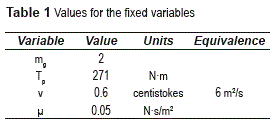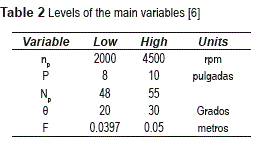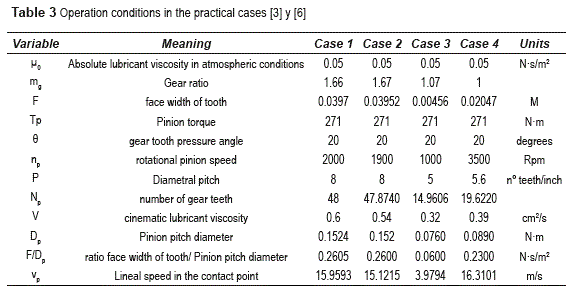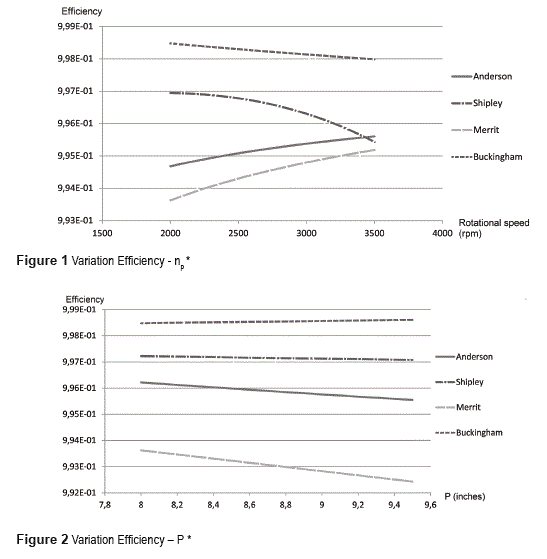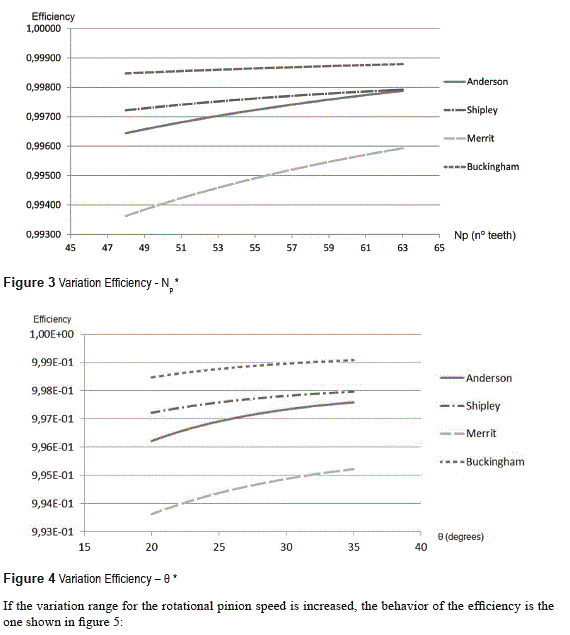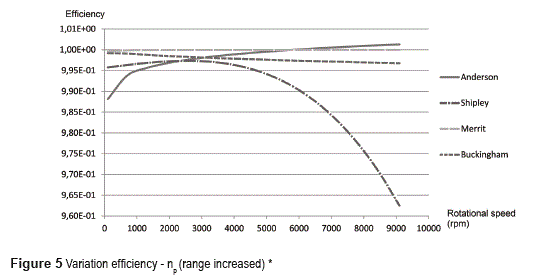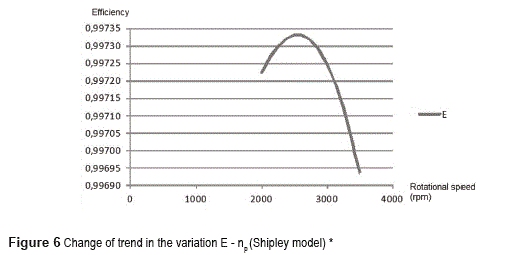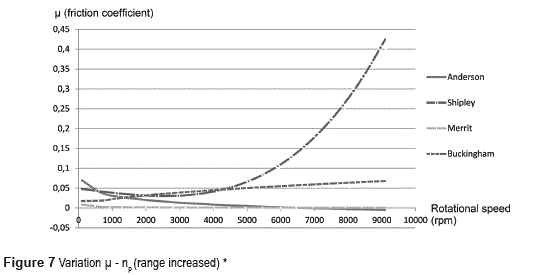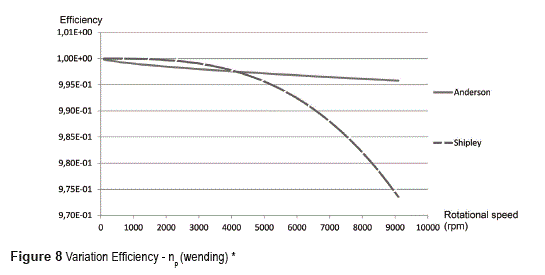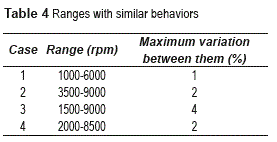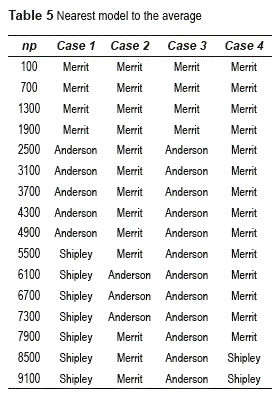Services on Demand
Journal
Article
Indicators
-
 Cited by SciELO
Cited by SciELO -
 Access statistics
Access statistics
Related links
-
 Cited by Google
Cited by Google -
 Similars in
SciELO
Similars in
SciELO -
 Similars in Google
Similars in Google
Share
Revista Facultad de Ingeniería Universidad de Antioquia
Print version ISSN 0120-6230
Rev.fac.ing.univ. Antioquia no.72 Medellín July/Sept. 2014
ARTÍCULO ORIGINAL
Analysis of power losses on spur gears using the design of experiments theory
Análisis de las pérdidas de potencia en transmisiones de engranajes cilindricos de dentado recto mediante la teoría del diseño de experimentos
Pedro J. Fernández Concellón*, Santiago Baselga Ariño
Escuela de Ingeniería y Arquitectura, Universidad de Zaragoza, C/ María de Luna sn. Edificio Betancourt. C.P. 50018. Zaragoza, España.
*Autor de correspondencia: teléfono:: + 0034 626788103 , correo electrónico: pjfercon@unizar.es (P. Fernández)
(Received May 19, 2013; accepted May 11, 2014)
Abstract
A review of 4 mathematical models proposed by different researchers has been carried out to analyse power losses in spur gears due to the sliding, rolling and wending phenomena. The main aim of this review is to detect the most significant factors that influence power losses in such conditions, whether or not exists some relationship between the analysed models and whether or not is feasible make assumptions for all kind of spur gears transmissions on the basis of the obtained conclusions. This analysis has been carried out using the Design of Experiments Theory, in particular using a 2k (k=4) factorial design with the purpose of detecting the most significant factors for each model. This experimental method only has allowed detecting the influence that each ''k'' factor has on the gears efficiency, in order to carry out a comparison between the 4 models. Once done that, it has been concluded firstly that each one of the analysed models is conditioned by the conditions around the experimentation and secondly that the analysed models are not applicable to any generic working situation, although it does not mean that for a specific group of determined conditions can be developed a generic model.
Keywords:Mathematical model, efficiency, power losses, mechanical transmissions, spur gears, Design of Experiments Theory
Resumen
En este trabajo se ha realizado una revisión de 4 modelos matemáticos propuestos por diferentes investigadores para analizar las pérdidas energéticas debidas al deslizamiento, rodadura y fricción del aire, de aplicación específica para transmisiones mecánicas formadas por engranajes cilindricos de dentado recto. El objetivo de esta revisión es analizar estos modelos para resaltar de qué variables, sobre las que puede ejercerse influencia fácilmente, dependen estos tipos de pérdidas, si existe relación entre los modelos y si las conclusiones extraídas pueden o no generalizarse para cualquier condición de trabajo con este tipo de transmisiones. Para la realización de este análisis se ha empleado la teoría del diseño de experimentos haciendo uso de un diseño factorial 2k (k=4), a fin de poder detectar las variables más significativas en cada modelo. Este método experimental únicamente ha servido para poder ver la influencia que cada una de las k variables tiene sobre la eficiencia de la transmisión, a fin de realizar una comparativa entre los modelos estudiados. Tras compararlos se ha concluido que primero, la obtención de los modelos estudiados está condicionada a las condiciones con que cada autor ha experimentado y segundo que, no son modelos aplicables a cualquier situación de trabajo, pero eso no significa que para un grupo de aplicaciones concretas puedan desarrollarse modelos genéricos.
Palabras Clave:Modelo matemático, eficiencia o pérdidas de potencia, transmisiones mecánicas, engranajes de dentado recto, Teoría de Diseño de Experimentos
Introduction
Mechanical transmissions are widely known and used in many kinds of machinery and vehicles in industry. Their uses go from little devices like watches to the engines of the biggest ships or planes in the world. These two examples, so different with respect to their size, make researchers consider seriously power losses having place inside them. Of all kinds of mechanical transmissions existing in the world (gears, pulleys, belts, cardan joints, etc.) gears are found in almost every device or machine and, now more than ever that efficiency and costs saving are crucial for the survival of companies and industries, know and understand such power losses is extremely important.
Power losses have been studied and analyzed since decades, especially during the last forty years [1-8] and [9], and this work is focused on those that happened with spur gears. Considering gears, spur gears are one of the most common ones that we can find [6] and this is the reason why we have chosen them in our research. Some researchers have focused their efforts trying to understand how power losses happen in this kind of transmissions [1-7]. They found that the most important power losses were due to sliding, rolling and wending phenomena. Their works were based on experimental studies with which tried to formulate a mathematical model that reproduced power losses under specific conditions. At the same time, these models were based on other models with which they obtained parameters directly related with power losses such as the friction coefficient.
The aims of our research are to analyze some models selected from a review of the existent literature, detect the most influencing factors over power losses on spur gears, determine whether or not there is a relationship between the results obtained with the different models and try to explain the reasons why such relationships are produced.
Conclusions obtained with our research will be used in an experimental study in the future that will be carried out in a laboratory in order to try to formulate an empiric mathematical model. In such model we will try to join the detected common points that exist in the studied models earlier, limiting the margin error as much as we can.
Materials and methods
A literature review has been carried out in order to find published papers with mathematical models which allowed calculating power losses on spur gears considering geometric and operation variables. It limits considerably our search because, although there are a lot of papers about power losses to this respect, the most of them do not contain mathematical models but only the obtained conclusions [4]. From this search nine papers have been selected [1-8] and [9], from which the models that four researchers developed earlier (Anderson, N y Loewenthal, S., Buckingham, Shipley y Merrit) have been selected.
The mathematical models (Eq. 1-8) have been evaluated on a transmission formed by spur gears. These models do not consider always the three phenomena that cause power losses cited earlier nor state such losses in the same way. Analyzing the parameters involved in the studied models, we have stated all of them so that the models are function of manageable parameters and common to them, related to the gears geometry and to the operation conditions. These are the models that have been studied according to the kind of losses that every researcher considers:
Anderson, N y Loewenthal, S. [6]:
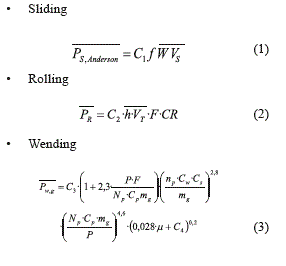
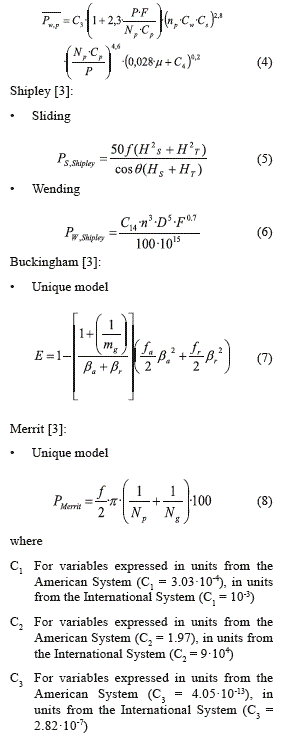
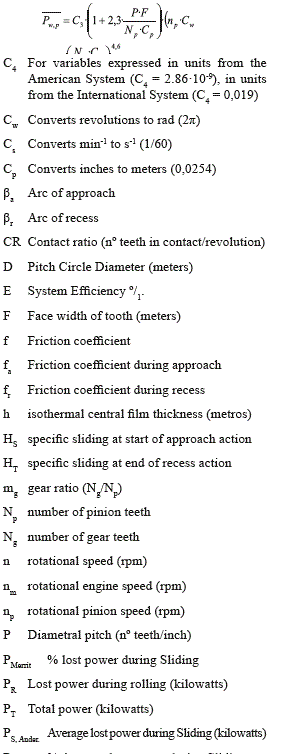
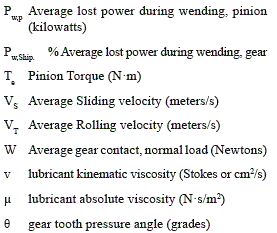
A mistake that exists in the Anderson and Loewenthal's paper [3, pag. 368] is corrected. In the constant values table, C1 for variables expressed in units from the international system is 10-3 and not 2*10-3, because the aim of this constant is to transform watts into kilowatts. Therefore, for variables expressed in units from the American system, C1 = 1.515l0-4 instead of 3.03l0-4.
In order to treat equally all models and so being able to establish comparisons between them, it has been defined PT (Eq. 9), that represents the total power that would be able to transmit if losses did not exist and the models have been expressed in terms of efficiency (Eq. 10-16), understanding it as the amount of power that the transmission takes advantage from expressed in °/τ.
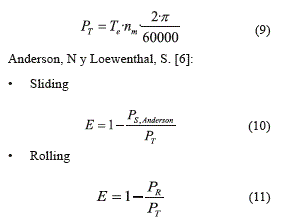
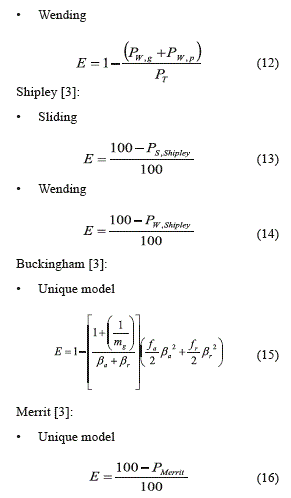
In order to determine which variables have more influence on power losses and so be able to make comparisons between the models, the Design of Experiments Theory has been selected. This is usually used in experimental works where the target variable in study depends on multiple factors. The factorial design 2k is one of the most used tools by researchers and one of the most important in the Design of Experiments Theory [10]. In spite of that our research does not carry out any real experimentation, this tool is greatly useful. It is like if every experiment had been carried out ''n'' times under the same conditions obtaining always the same results [11].
Previous to use the Design of Experiments Theory it has been necessary, among all variable that are involved in the models (Eq. 1-8), to select those that can be identify and modify more easily in a transmission of this kind (number of gear teeth, face width of tooth, diametral pitch, gear tooth pressure angle, pinion torque, gear ratio, lubricant viscosity and rotational pinion speed).
It has been selected a factorial design 2k with k=4 (4 variable are evaluated in two operation levels) and the variables used are gear tooth pressure angle (9), rotational pinion speed (np), number of gear teeth (Np), face width of tooth (F) and diametral pitch (P). (14) There are five variable because although in the model that considers wending losses there are involved four variable only (gear tooth pressure angle does not intervene), in the rest of models it does and in such cases we have studied two situations involving four variable grouped in different ways. The rest of variable involved in the models (table 1) have been fixed according to their values proposed in the (15) papers that we have consulted [6].
Models are separated according to the kind of losses to analyze, and the Design of Experiments has been carried out according to it. The selected variables for the Design of Experiments have been evaluated in the levels (table 2) shown below taking into account the low and high values considered by Anderson and Loewenthal [6].
Once the Design of Experiments has been carried out and the models have been compared with respect to the influence that every variable has on the transmission efficiency, the mathematical models (Eq. 1-8) from each author have been joined (Eq. 17-20) in order to determine and compare the transmission global efficiency.
Anderson, N y Loewenthal, S.:
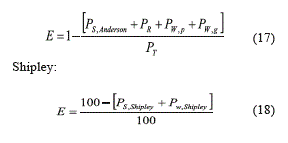
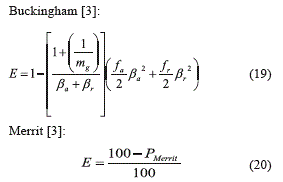
These global models have been (Eq. 17-20) evaluated in four practical cases with the aim of analyze whether or not exists a mathematical model able to estimate losses which is representative from the analyzed models. The data of the four practical cases (Table 3) come from the papers [3] and [6] and these are shown below:
Results
First we will analyze the results coming from the Design of Experiments Theory (referred to the behavior trends of the models) and then we will do the same with those coming from the practical cases (referred to the quantitative results).
The Design of Experiments has been applied to all models (Eq. 17-20) having selected the variables np, P, Np and θ and these others np, θ, P y F (case 2) for the Anderson y Loewenthal model.
Friction Losses
For all models (Eq. 10, 13, 15-16) the most significant variable was the one related to the rotational pinion speed. However, the results about the influence that every variable has on the transmission efficiency seem to be not very clear.
For the Anderson and Loewenthal model (Eq. 10) and the Merrit model (Eq.16) the higher the rotational pinion speed is, the higher the transmission efficiency. This is the opposite that happens in the Shipley (Eq. 13) and Buckingham (Eq. 15) models. Also, with these two models but not with the Merrit and the Anderson and Loewenthal models, the higher the diametral pitch is, the higher the system efficiency is.
From the analysis of the Shipley model (Eq. 13) we found that depending on the range in which the efficiency was evaluated in this model, the trends with respect to the system efficiency changed. Since for carrying out the Design of Experiments there has to be limited to two levels the range in which the variables can vary, such limitation can affect to the model behavior. This can be appreciated in figures 1-4 where it is represented the variation of the system efficiency with the variation of the every selected variable restricted to the two levels (minimum and maximum).
In three of the four models (Eq. 10, 15-16), for the range defined earlier in the Design of Experiments, can be appreciated that efficiency maintains a stable behavior, however the Shipley model (Eq. 13) has a turning point (see Figure 6) which suggests that the results for this model must be keep apart from the others.
Analyzing the behavior of the efficiency when the rotational pinion speed varies (the most significant variable for all models) we saw that efficiency is inversely proportional to the friction coefficient. So clear it is that the graphs shownin Figure 7 (it represents the variation friction coefficient - np) and the ones shown in figure 5 are symmetric with respect to the X axe.
Since the models used for estimating the friction coefficient (Eq. 10, 13, 15-16) come from experimentation (empirical data) and such experimentation was carried out under particular conditions [2], it is understandable that for the conditions under which the losses models have been analyzed in our work the results are different.
Rolling losses
The Anderson y Loewenthal model (Eq. 11) is the only one that evaluates separately this kind of losses [3] and we have studied with it two situations (two cases with different groups of variables) in order to analyze which of the variables that differs in both cases (F or θ) has more influence in the system efficiency. The results state that rotational pinion speed keeps being the variable that has more influence on efficiency and that the face width of tooth is less influential than the gear tooth pressure angle.
As there are not any other model considering rolling losses separately, we cannot obtain more results not compare them.
Wending losses
This phenomenon is studied for the Shipley and the Anderson and Loewenthal models (Eq. 12 and 14). Both models do not consider the gear tooth pressure angle so we have carried out the Design of Experiments considering these variables (np, Np, F and P). Similarly to the earlier cases, rotational pinion speed is the most significant variable on the efficiency and the variation trends are similar in both models (see Figures 8 - 11).
Global losses
The analysis of the models (Eq. 17-20) joining all kind of losses shows interesting results as it can be appreciated analyzing the variation ranges for the rotational pinion speed for every case (table 4), where the models behavior are similar.
For the range considered in all cases (Table 5), the model that has a minimum difference with respect to the average of the global efficiency calculated for the models (Eq. 17-20).
From these results it can be appreciated that the Merrit model (Eq. 20) is the nearest to the average in all cases in the range between 100 and 1900 rpm. In the cases 2 and 4 it continues being the nearest but in the range between 100 y 5500 rpm, however in cases 1 and 3 is the Anderson and Loewenthal model (Eq. 17) which is the nearest in the range between 2500 and 4900 rpm.
The Shipley model (Eq. 18) only shows values close to the average in the range between 5500 and 9100 rpm and in the case 4 between 8500 and 9100 rpm.
It is remarkable that Buckingham model (Eq. 19) does not appear in table 5 because the results obtained with it are not the nearest in any case and in any range to the average.
Discussion
First of all, it must be considered that the use of the Design of Experiments Theory in our research has allowed only two things: detect the behavior of the parameter related to the system efficiency and the trend of such parameter with respect to the variation of the other parameters studied. Although the purpose of such tool is to detect the most significant parameters in a working system in order to develop a mathematical model that adjusts to it [10], for us the Design of Experiments Theory has served as a complementary method to compare and detect differences between the studied models (Eq. 10-16). This procedure has not altered the models nor the results obtained with them in any time.
Secondly and with respect to the models studied in this work (Eq. 10-16), we must remark that they are based on data and variable whose behavior equations have been obtained from experimentation. This can be appreciated in the obtained results seeing that some models behave differently depending on the range in which they are evaluated, showing different results with respect to their trend on the system efficiency. Nevertheless, in any of the models it has been demonstrated that the rotational pinion speed is the most influential variable on the system efficiency from the ones selected in our study.
Considering sliding losses, it has been clear that the analyze models cannot be applied to general situations because they depend on models that each researcher has chosen for calculating the friction coefficient. It does not mean that it cannot be possible to develop a new model applicable to a general situation but that the models analyzed have an employability and validity limited by the conditions fixed during their formulation.
The evaluation of the models considering all kind of losses at the same time reinforces this idea. In all practical cases analyzed it has been seen that the models present similar behaviors in specific ranges of the rotational pinion speed but they are not generalizable to any range because they do not coincide for every case.
The same conclusion can be extracted from the results obtained trying to average out the values that were obtained with each practical case. There is not a clear conclusion that allows to state firmly that one or several models can be used for any operational situation with the gears. What is clear is that the Buckingham model is the furthest one to the averaged values in all cases but even so, it does not mean that it is a bad model.
From all of that it can be concluded that the analysis of the efficiency on the basis of the lost power in mechanic transmissions presents a high complexity, requires from experimentation in order to extract reliable conclusions and only these will be able to be applied rigorously to situations with equivalent operational conditions to the ones considered during the experimentation. Out of these conditions, the models developed by other researchers can be an idea more or less clear about the influence of some variables in the studied phenomenon but not go further. In order to obtain a reliable and quantifiable evaluation of our problem, it will have to be reproduced in a laboratory and experimentation will have to be applied.
Finally, we would like to make a last comment about the risk that exists using models developed by other researchers.
It is convenient to review thoroughly such models come from and the meaning of the variable and parameter intervening on them. During our research, we have detected some errors with respect to conversion units in some equations (see explanation below Eq. 8). It is easily detectable in equations purely theoretical but not in equations coming from experimentation. In these ones, it is very important follow the instructions of the researcher who formulate the equation with respect to units because there are constants that are valid only for such units.
References
1. V. Stavytskyy, P. Nosko, P. Fil, A. Karpov, N. Velychko. ''Load-independent power losses of gear systems: A review''. TEKA Kom. Mot. i Energ. Roln. 10B. 2010. pp. 205-213. [ Links ]
2. H. Xu. Development of a generalized mechanical efficiency prediction methodology for gear pairs. Dissertation. Ohio State University. Ohio, USA. 2005. pp. 258. [ Links ]
3. N. Anderson, S. Loewenthal. Comparison of Spur Gear Efficiency. Prediction Methods. Army Research and Technology Labs., NASA-CP-2210. Technical report. Cleveland, USA. 1983. pp. 365-382. [ Links ]
4. M. Pleguezuelos, J. Pedrero. ''Modelo analítico de rendimiento de engranajes rectos convencionales''. Revista Iberoamericana de Ingeniería Mecánica. Vol. 13. 2009. pp. 27-38. [ Links ]
5. N. Anderson, S. Loewenthal. Effect of geometry and operating conditions on spur gear system power loss. AVRADCOM, NASA. National Technical Information Service. US Department of Commerce. Technical Memorandum 81426. 80-C-2. San Francisco, USA. 1980. pp. 1-33. [ Links ]
6. N. Anderson, S. Loewenthal. Spur-Gear-System Efficiency at part and full load. Scientific and Technical Information Office, NASA. AVRADCOM. Technical report. 162. Washington D. C., USA. 1980. pp. 39. [ Links ]
7. J. Coy, D. Townsend, E. Zaretsky. Gearing. NASA, AVSCOM. Technical Report. NASA-RP-1152. Washington, D.C., USA. 1985. pp. 76 [ Links ]
8. D. Dudley. Manual de Engranajes: Diseño, manufactura y aplicación de engranajes. Ed. Compañía Editorial Continental S.A. México. 1973. pp. 945. [ Links ]
9. Y. Michlin, V. Myunster. ''Determination of power losses in gear transmissions with rolling and sliding friction incorporated''. Mechanism and Machine Theory. Vol. 37. 2002. pp. 167-174. [ Links ]
10. D. Montgomery, G. Runger. Applied statistics and probability for engineers. 3rd ed. Ed. John Wiley and Sons Inc. New York, USA. 2003. pp. 707. [ Links ]
11. D. Montgomery. Design and analysis of experiments. 5th ed. Ed. John Wiley and Sons, Inc. New York, USA. 2001. pp. 684. [ Links ]













